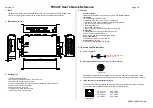
Special operating procedures for use when removing plastic residue
The industrial fluidised bath detailed in this manual is suitable for “burning off” plastic residue from
plastic machine tools, and is effective on the full range of polymers. In addition, the bath is also effective
on rubber, epoxy resins and various paints. The bath provides a safe, dry, and fast means of removing all
plastic residue with the minimum effort.
The process is controlled at a uniform temperature so that distortion of tooling due to uneven heating
which occurs when using other heating methods is avoided. Furthermore, as the fluidised bed is
non-abrasive, physical damage to parts is minimal.
The cleaning process relies on heat being transferred from the fluidised bed to the immersed tools, the
heat degrading the plastic residue. Objects to be cleaned should be supported in a basket or suitable
holder for ease of handling and lowered into the fluidised bed. To avoid physical damage and local
overheating, it is important to ensure that any items placed in the bed are supported and not allowed to
rest either on the porous plate at the bottom of the bed or against the wall of the inner container. The
bath should be operated generally in the temperature range of 450°C to 500°C, depending on the
polymer to be removed. The process time depends upon the thermal mass of the object, the amount and
type of polymer to be removed. During the first two thirds of the process time the polymer is reduced to
a tar mix, in this phase all the initially combustible products of the polymer are emitted from the fluidised
bath in the form of fumes that must be extracted and treated by suitable fume handling equipment.
During the last third of the process time the polymer is reduced to carbon which either burns away or
remains loosely bound to the object being cleaned.
Any carbon or incombustible filler that remains on the processed item can be removed by a secondary
cleaning operation, either by brushing or some form of water wash.
It is important to ensure that the items being processed do not exceed the maximum loading capacity
(see Technical Specification) and that they are loaded into the fluidised bath in such a way that the
fluidisation is not impended.
THE PROCESS RELIES UPON GOOD FLUIDISATION TO ENSURE GOOD HEAT TRANSFER; OVERLOADING
OR INCORRECT LOADING OF THE BATH WILL RESULT IN EXTENDED CYCLE TIMES GIVING INFERIOR
RESULTS. LOCAL OVERHEATING MAY ALSO OCCUR, GIVING RISE TO PREMATURE HEATER FAILURE AND
POSSIBLE DISTORTION OF THE INNER CONTAINER.
The aluminium oxide fluidising medium does not degrade but will need to be replenished due to loss
from spillage or entrainment in the exhaust (from where it may be recovered by a cyclone trap).
All articles should be completely cleaned and removed from the bed before shut down. Corrosion of
processed parts could be seriously increased if they are left immersed overnight. Furthermore, residual
polymer, instead of being burned off in a fluidised state, could percolate down through a static bed and
settle on the porous plate to cause a blockage and result in poor fluidisation.
When parts are removed from the bed they should be allowed to cool in air and, whilst still warm, treated
to prevent rusting.
It should be noted that some plastics and, in particular, paints contain fillers. These fillers are usually
inorganic materials and will not therefore burn when put into a fluidised bath, with the result that the
material falls away from the article being cleaned and is retained in the bath, either on the surface or at
the base of the bath, depending upon the density of the material involved. If this happens it is
recommended that the bath be checked and cleaned at least once a week or more frequently if the bath
is used continuously.
17
Содержание Techne IFB-201
Страница 1: ...Instruction Manual Version 9 Industrial Fluidised Bath System IFB 201 ...
Страница 23: ...ACCESSORIES AND SPARE PARTS 23 ...
Страница 26: ...26 26 ...












































